Eneko Agirre
Lengoia eta Informatikoak saila, Euskal Erriko Universitatea
Adding simple structure at inference improves Vision-Language Compositionality
Jun 11, 2025Abstract:Dual encoder Vision-Language Models (VLM) such as CLIP are widely used for image-text retrieval tasks. However, those models struggle with compositionality, showing a bag-of-words-like behavior that limits their retrieval performance. Many different training approaches have been proposed to improve the vision-language compositionality capabilities of those models. In comparison, inference-time techniques have received little attention. In this paper, we propose to add simple structure at inference, where, given an image and a caption: i) we divide the image into different smaller crops, ii) we extract text segments, capturing objects, attributes and relations, iii) using a VLM, we find the image crops that better align with text segments obtaining matches, and iv) we compute the final image-text similarity aggregating the individual similarities of the matches. Based on various popular dual encoder VLMs, we evaluate our approach in controlled and natural datasets for VL compositionality. We find that our approach consistently improves the performance of evaluated VLMs without any training, which shows the potential of inference-time techniques. The results are especially good for attribute-object binding as shown in the controlled dataset. As a result of an extensive analysis: i) we show that processing image crops is actually essential for the observed gains in performance, and ii) we identify specific areas to further improve inference-time approaches.
Instructing Large Language Models for Low-Resource Languages: A Systematic Study for Basque
Jun 09, 2025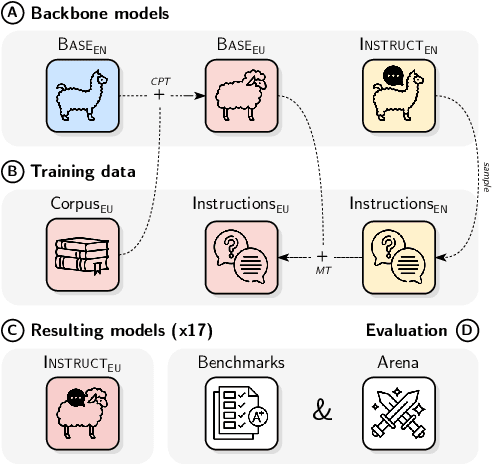
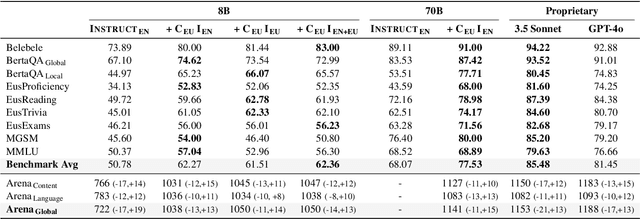
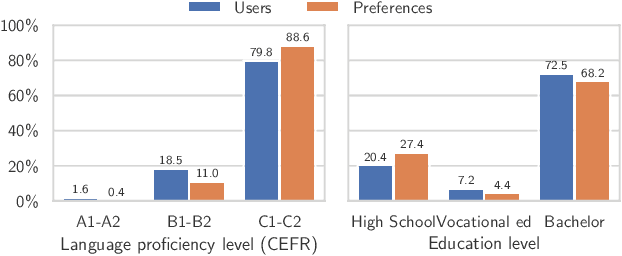

Abstract:Instructing language models with user intent requires large instruction datasets, which are only available for a limited set of languages. In this paper, we explore alternatives to conventional instruction adaptation pipelines in low-resource scenarios. We assume a realistic scenario for low-resource languages, where only the following are available: corpora in the target language, existing open-weight multilingual base and instructed backbone LLMs, and synthetically generated instructions sampled from the instructed backbone. We present a comprehensive set of experiments for Basque that systematically study different combinations of these components evaluated on benchmarks and human preferences from 1,680 participants. Our conclusions show that target language corpora are essential, with synthetic instructions yielding robust models, and, most importantly, that using as backbone an instruction-tuned model outperforms using a base non-instructed model, and improved results when scaling up. Using Llama 3.1 instruct 70B as backbone our model comes near frontier models of much larger sizes for Basque, without using any Basque data apart from the 1.2B word corpora. We release code, models, instruction datasets, and human preferences to support full reproducibility in future research on low-resource language adaptation.
WiCkeD: A Simple Method to Make Multiple Choice Benchmarks More Challenging
Feb 25, 2025Abstract:We introduce WiCkeD, a simple method to increase the complexity of existing multiple-choice benchmarks by randomly replacing a choice with "None of the above", a method often used in educational tests. We show that WiCkeD can be automatically applied to any existing benchmark, making it more challenging. We apply WiCkeD to 6 popular benchmarks and use it to evaluate 18 open-weight LLMs. The performance of the models drops 12.1 points on average with respect to the original versions of the datasets. When using chain-of-thought on 3 MMLU datasets, the performance drop for the WiCkeD variant is similar to the one observed when using the LLMs directly, showing that WiCkeD is also challenging for models with enhanced reasoning abilities. WiCkeD also uncovers that some models are more sensitive to the extra reasoning required, providing additional information with respect to the original benchmarks. We relase our code and data at https://github.com/ahmedselhady/wicked-benchmarks.
Data Contamination Report from the 2024 CONDA Shared Task
Jul 31, 2024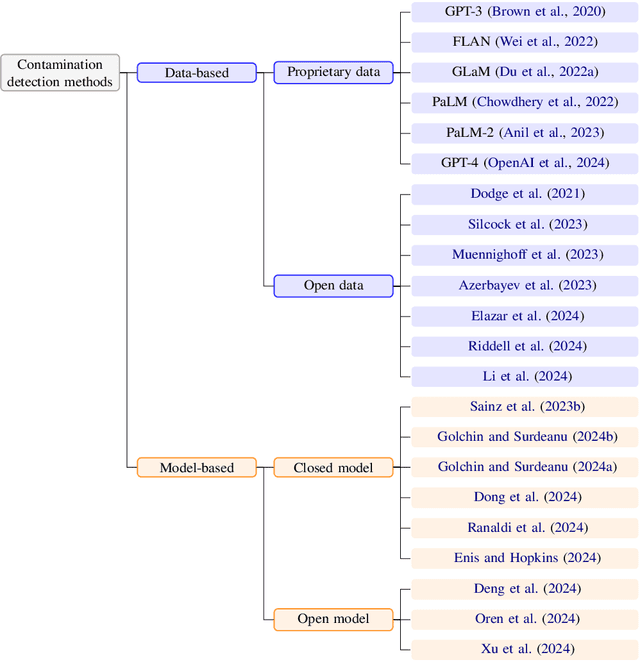
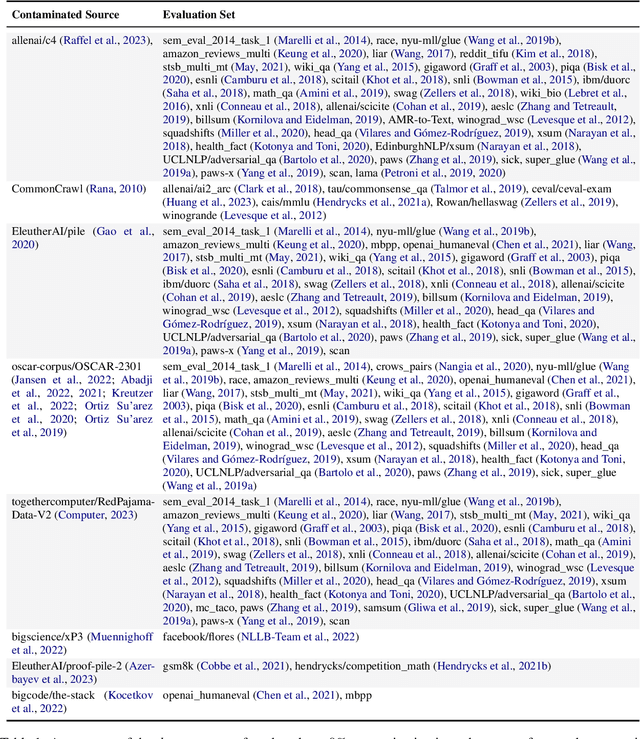
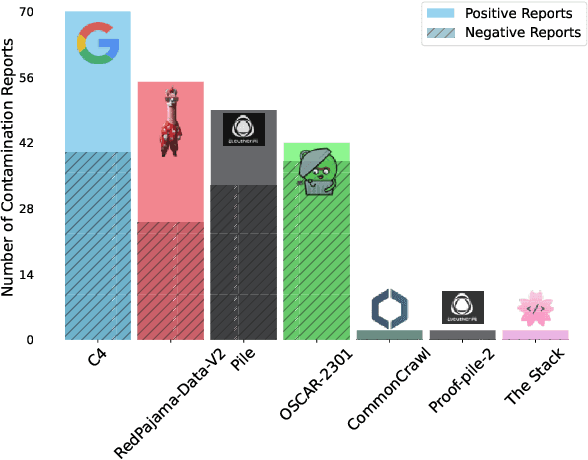
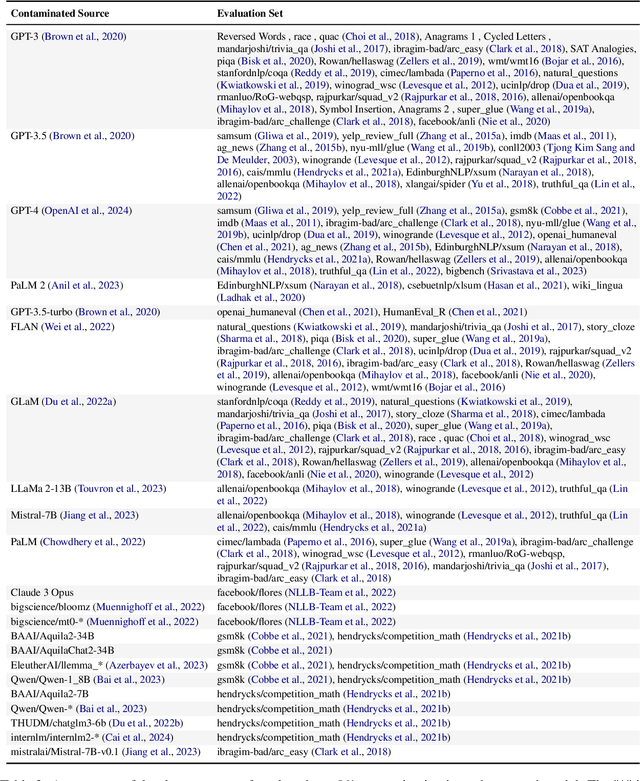
Abstract:The 1st Workshop on Data Contamination (CONDA 2024) focuses on all relevant aspects of data contamination in natural language processing, where data contamination is understood as situations where evaluation data is included in pre-training corpora used to train large scale models, compromising evaluation results. The workshop fostered a shared task to collect evidence on data contamination in current available datasets and models. The goal of the shared task and associated database is to assist the community in understanding the extent of the problem and to assist researchers in avoiding reporting evaluation results on known contaminated resources. The shared task provides a structured, centralized public database for the collection of contamination evidence, open to contributions from the community via GitHub pool requests. This first compilation paper is based on 566 reported entries over 91 contaminated sources from a total of 23 contributors. The details of the individual contamination events are available in the platform. The platform continues to be online, open to contributions from the community.
BiVLC: Extending Vision-Language Compositionality Evaluation with Text-to-Image Retrieval
Jun 14, 2024Abstract:Existing Vision-Language Compositionality (VLC) benchmarks like SugarCrepe are formulated as image-to-text retrieval problems, where, given an image, the models need to select between the correct textual description and a synthetic hard negative text. In this work we present the Bidirectional Vision-Language Compositionality (BiVLC) dataset. The novelty of BiVLC is to add a synthetic hard negative image generated from the synthetic text, resulting in two image-to-text retrieval examples (one for each image) and, more importantly, two text-to-image retrieval examples (one for each text). Human annotators filter out ill-formed examples ensuring the validity of the benchmark. The experiments on BiVLC uncover a weakness of current multimodal models, as they perform poorly in the text-to-image direction. In fact, when considering both retrieval directions, the conclusions obtained in previous works change significantly. In addition to the benchmark, we show that a contrastive model trained using synthetic images and texts improves the state of the art in SugarCrepe and in BiVLC for both retrieval directions. The gap to human performance in BiVLC confirms that Vision-Language Compositionality is still a challenging problem. BiVLC and code are available at https://imirandam.github.io/BiVLC_project_page.
Event Extraction in Basque: Typologically motivated Cross-Lingual Transfer-Learning Analysis
Apr 09, 2024Abstract:Cross-lingual transfer-learning is widely used in Event Extraction for low-resource languages and involves a Multilingual Language Model that is trained in a source language and applied to the target language. This paper studies whether the typological similarity between source and target languages impacts the performance of cross-lingual transfer, an under-explored topic. We first focus on Basque as the target language, which is an ideal target language because it is typologically different from surrounding languages. Our experiments on three Event Extraction tasks show that the shared linguistic characteristic between source and target languages does have an impact on transfer quality. Further analysis of 72 language pairs reveals that for tasks that involve token classification such as entity and event trigger identification, common writing script and morphological features produce higher quality cross-lingual transfer. In contrast, for tasks involving structural prediction like argument extraction, common word order is the most relevant feature. In addition, we show that when increasing the training size, not all the languages scale in the same way in the cross-lingual setting. To perform the experiments we introduce EusIE, an event extraction dataset for Basque, which follows the Multilingual Event Extraction dataset (MEE). The dataset and code are publicly available.
Latxa: An Open Language Model and Evaluation Suite for Basque
Mar 29, 2024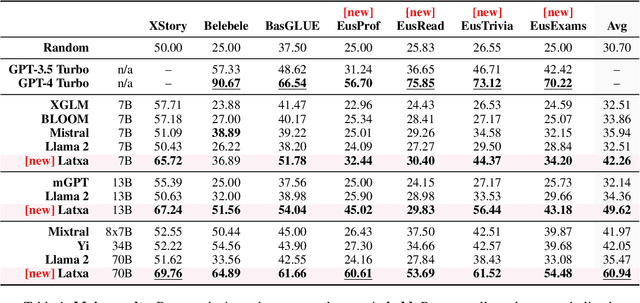
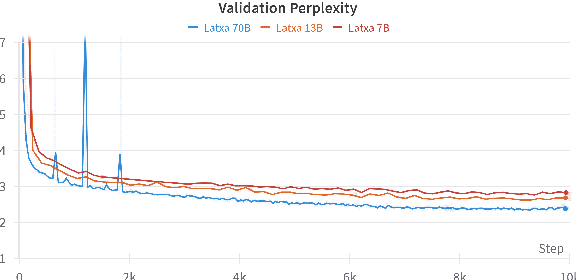

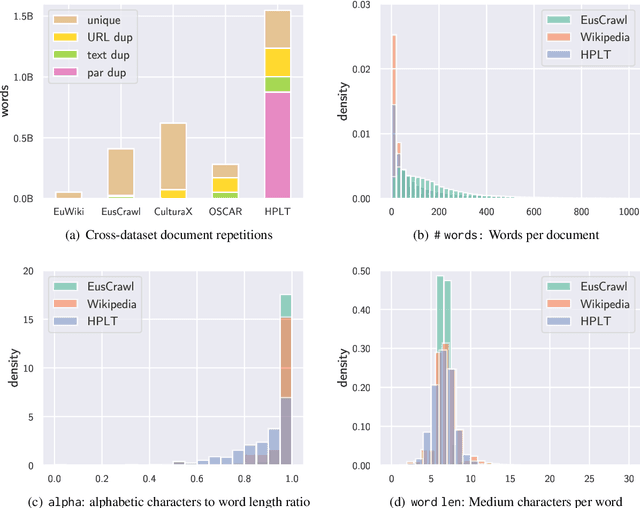
Abstract:We introduce Latxa, a family of large language models for Basque ranging from 7 to 70 billion parameters. Latxa is based on Llama 2, which we continue pretraining on a new Basque corpus comprising 4.3M documents and 4.2B tokens. Addressing the scarcity of high-quality benchmarks for Basque, we further introduce 4 multiple choice evaluation datasets: EusProficiency, comprising 5,169 questions from official language proficiency exams; EusReading, comprising 352 reading comprehension questions; EusTrivia, comprising 1,715 trivia questions from 5 knowledge areas; and EusExams, comprising 16,774 questions from public examinations. In our extensive evaluation, Latxa outperforms all previous open models we compare to by a large margin. In addition, it is competitive with GPT-4 Turbo in language proficiency and understanding, despite lagging behind in reading comprehension and knowledge-intensive tasks. Both the Latxa family of models, as well as our new pretraining corpora and evaluation datasets, are publicly available under open licenses at https://github.com/hitz-zentroa/latxa. Our suite enables reproducible research on methods to build LLMs for low-resource languages.
Grounding Spatial Relations in Text-Only Language Models
Mar 20, 2024



Abstract:This paper shows that text-only Language Models (LM) can learn to ground spatial relations like "left of" or "below" if they are provided with explicit location information of objects and they are properly trained to leverage those locations. We perform experiments on a verbalized version of the Visual Spatial Reasoning (VSR) dataset, where images are coupled with textual statements which contain real or fake spatial relations between two objects of the image. We verbalize the images using an off-the-shelf object detector, adding location tokens to every object label to represent their bounding boxes in textual form. Given the small size of VSR, we do not observe any improvement when using locations, but pretraining the LM over a synthetic dataset automatically derived by us improves results significantly when using location tokens. We thus show that locations allow LMs to ground spatial relations, with our text-only LMs outperforming Vision-and-Language Models and setting the new state-of-the-art for the VSR dataset. Our analysis show that our text-only LMs can generalize beyond the relations seen in the synthetic dataset to some extent, learning also more useful information than that encoded in the spatial rules we used to create the synthetic dataset itself.
Improving Explicit Spatial Relationships in Text-to-Image Generation through an Automatically Derived Dataset
Mar 01, 2024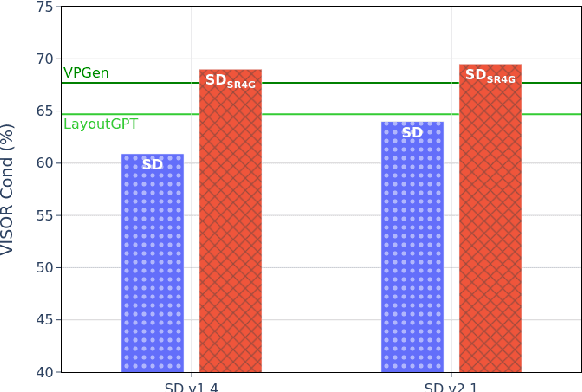


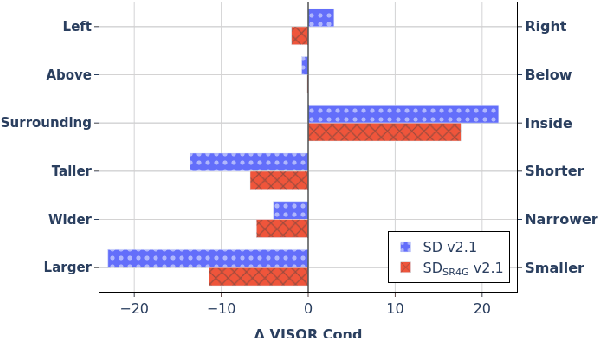
Abstract:Existing work has observed that current text-to-image systems do not accurately reflect explicit spatial relations between objects such as 'left of' or 'below'. We hypothesize that this is because explicit spatial relations rarely appear in the image captions used to train these models. We propose an automatic method that, given existing images, generates synthetic captions that contain 14 explicit spatial relations. We introduce the Spatial Relation for Generation (SR4G) dataset, which contains 9.9 millions image-caption pairs for training, and more than 60 thousand captions for evaluation. In order to test generalization we also provide an 'unseen' split, where the set of objects in the train and test captions are disjoint. SR4G is the first dataset that can be used to spatially fine-tune text-to-image systems. We show that fine-tuning two different Stable Diffusion models (denoted as SD$_{SR4G}$) yields up to 9 points improvements in the VISOR metric. The improvement holds in the 'unseen' split, showing that SD$_{SR4G}$ is able to generalize to unseen objects. SD$_{SR4G}$ improves the state-of-the-art with fewer parameters, and avoids complex architectures. Our analysis shows that improvement is consistent for all relations. The dataset and the code will be publicly available.
PixT3: Pixel-based Table To Text generation
Nov 16, 2023Abstract:Table-to-Text has been traditionally approached as a linear language to text problem. However, visually represented tables are rich in visual information and serve as a concise, effective form of representing data and its relationships. When using text-based approaches, after the linearization process, this information is either lost or represented in a space inefficient manner. This inefficiency has remained a constant challenge for text-based approaches making them struggle with large tables. In this paper, we demonstrate that image representation of tables are more space-efficient than the typical textual linearizations, and multi-modal approaches are competitive in Table-to-Text tasks. We present PixT3, a multimodal table-to-text model that outperforms the state-of-the-art (SotA) in the ToTTo benchmark in a pure Table-to-Text setting while remaining competitive in controlled Table-to-Text scenarios. It also generalizes better in unseen datasets, outperforming ToTTo SotA in all generation settings. Additionally, we introduce a new intermediate training curriculum to reinforce table structural awareness, leading to improved generation and overall faithfulness of the models.
 Add to Chrome
Add to Chrome Add to Firefox
Add to Firefox Add to Edge
Add to Edge